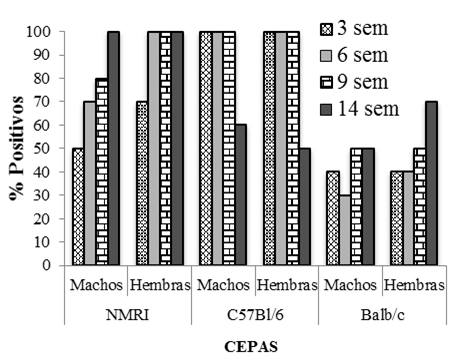Prevalence and degree of parasitation by enteric flagelates in mice nmri, C57Bl/6 and Balb/c
Keywords:
Giardia muris, Trichomona muris, Spironucleus muris, C57Bl/6, Balb/cAbstract
In order to analyze the prevalence and parasitation degree by enteric flagellates in NMRI, C57Bl/6 and Balb/c mice, discriminating on the basis of strain, age and sex of animals produced conventionally in animal facilities of the Universidad Centroccidental Lisandro Alvarado (Venezuela), 50 mice were selected by strain and sex, and 10 by age (3, 5, 7, 9 and 14 weeks) (N = 300). They were sampled both fresh feces and intestinal contents at three differents sections (duodenum, yeyuno-ileon and cecum), for direct observation and smears stained with Giemsa. The data was analyzed with Chi-square, Mann-Whitney, Kruskal-Wallis test, correlation of Spearman and factor analysis. Giardia muris was located at cecum of NMRI mice (100%) and 99% of C57Bl/6 and Balb/c. At yeyuno-ileon in 89% of C57Bl/6, 84% of NMRI and 46% of Balb/c; and at duodenum, in male C57Bl/6 (73%), which increases the prevalence with age. Trichomonas muris was identified in 58-76% of the three strains with the highest prevalence in males NMRI and C57B1/6. Spironucleus muris, only 70% of the six-weeks-old NMRI were identified. The less parasitized strain is the Balb/c. There are significant differences in the prevalence of three parasitic diseases among the strains studied, about Giardia there are differences between the ages in the NMRI and C57Bl/6 and about Trichomonas between both sex. It is recommended to consider animals strain produced and/or used in research, their sex and age in order to establish the sanitary controls aimed to enteric flagellates.
Downloads
References
Jalili N, Demes P, Holkova R. The ocurrence of protozoa in the intestinal microflora of laboratory mice. Bratisl Lek Listy 1989; 90(1):42-44.
Bicalho K, Araújo F, Rocha R., Carvalho O. Sanitary profile in mice and rat colonies in laboratory animal houses in Minas Gerais: I - Endo and ectoparasites. Arq Bras Med Vet Zootec 2007; 59(6):1478-1484.
Percy D, Barthold S. Pathology of laboratory rodents and rabbits. Iowa State University Press/Ames. Primera edición. EEUU. 1993; 229 pp.
Zuñiga J, Turmari J, Milocco S, Piñeiro R. Ciencia y tecnología en protección y experimentación animal. Edit. McGraw-Hill. Madrid. España. 2001.
Goodwin B, Yarbrough L, Head K. Rats and mice: parasitic diseases. Lab Ani Med Sci. Series II. Universidad de Texas Houston. 2000. 30pp.
Venkatesan P, Finch R, Wakelin D. A comparison of mucosal inflammatory responses to Giardia muris in resistant B10 and susceptible Balb/c mice. Parasite Immunol 1997;19:137-143
Baker D. , Malineni S, Taylor H. Experimental infection of inbred mouse strain with Spironucleus muris. Vet Parasitol 1998; 77(4):301-310.
Brett S, Cox F. Immunological aspects of Giardia muris and Spironucleus muris infections in inbred and outbred strains of laboratory mice: a comparative study. Parasitology. 1982a; 8(1):85-99.
Malcolm J, O’Donoghue P. Patología de los animales de laboratorio. Diagnóstico y tratamiento. Editorial Acribia. Zaragoza. España. 1984. 305 pp.
Sebesteny A. Pathogenicity of intestinal flagellates in mice. Lab Anim 1969; 3:71-77.
Brett S, Cox F. Interactions between the intestinal flagelates Giardia muris and Spironucleus muris and the blood parasites Babesia microti, Plasmodium yoelii and Plasmodium berghei in mice. Parasitology. 1982b. 85(1):101-110.
Flynn R. Parasites of laboratory animals. Iowa State University Press/Ames. Primera edición. EEUU. 1973; 884 pp.
Nicklas W; Baneux P; Boot R; Decelle T; Deeny A; Fumanelli M; et al. FELASA. Recommendations for the health monitoring of rodent and rabbit colonies in breeding and experimental units. Lab Ani 2002; 36:20-42.
Carty A. Opportunistic infections of mice and rats: Jacoby and Lindsey Revisited. Ilar J 2008; 49(3):272:276.
Daniels C., Belosevic M. Comparison of the course of infection with Giardia muris in male and female mice. Int J Parasitol 1995; 25:131-135.
Institute for Laboratory Animal Research. Companion guide to infectious diseases of mice and rats. Commission on life Sciences. National Research Council. 1991; 108 pp.

Published
How to Cite
Issue
Section
Gaceta de Ciencias Veterinarias se apega al modelo Open Access, por ello no se exige suscripción, registro o tarifa de acceso a los usuarios o instituciones. Los usuarios pueden leer, descargar, copiar, distribuir, imprimir y compartir los textos completos inmediatamente después de publicados, se exige no hacer uso comercial de las publicaciones. Para la reproducción parcial o total de los trabajos o contenidos publicados, se exige reconocer los derechos intelectuales de los autores y además, hacer referencia a esta revista. La publicación de artículos se hace sin cargo para los autores. Los trabajos pueden consultarse y descargarse libremente, y de manera gratuita, en extenso en versión digital, desde su enlace Web institucional. Los textos publicados son propiedad intelectual de sus autores. Las ideas, opiniones y conceptos expuestos en los trabajos publicados en la revista representan la opinión de sus autores, por lo tanto, son estos los responsables exclusivos de los mismos.


